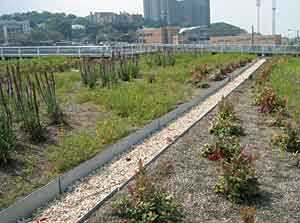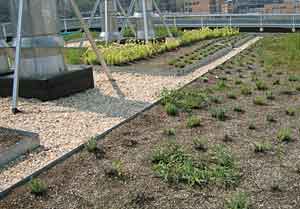Designing with Green Roofs: Maximizing Sustainability and Stormwater Management
The Pieces Must Fit Together
The Hanging Gardens in ancient Babylon, New York City's Rockefeller Center Plaza, and earth-bermed houses of the 1970s, are built-up roof gardens using conventional heavyweight soils. New technologies provide architects with interrelated roof components, creating a lightweight viable living roof by design.
|
The most common deterrent to adding a green roof is the cost of the additional structure required to support the roof load. Jeremy S. Edmunds, Assoc. AIA, P.E., LEED-AP, project manager at Brownfield redeveloper Cherokee Northeast, in East Rutherford, New Jersey states, "We haven't built a green roof yet, but are studying them for several projects in the Northeast. If waterproofing and structural loading concerns are addressed, we feel green roofs will turn heat island eyesores into welcoming gardens."
Green roofs add weight, or dead load, to the roof of a structure and must be factored into its design. Besides the weight of the roof membrane and insulation, the weight of the green roof components, growing media (soil), and plants must be taken into consideration. Of these, the soil weight is typically expressed as a saturated or wet weight. Some extensive green roofs can weigh little more than a traditional roof with ballast; however this weight can increase substantially as the thickness of the soil is increased to accommodate the wider variety of plants that can be placed in an Intensive green roof. The soil for a green roof can weigh between 5.5 to 7.5 pounds per square foot per inch of depth (wet or saturated weight), so on a typical extensive green roof, a three-inch depth of soil would add 16.5 to 22.5 pounds per square foot. This spread in weight is largely dependent on the composition of the soil, and can vary between green roof providers.
|
The Guidelines for the Planning, Execution and Upkeep of Green Roof Sites, also known in Germany as the FLL standards, is the international standard for green roofs. For 35 years, Germany has been greening its roofs, and this technology is now being used in the U.S. New building codes are being developed for green roofs and testing standards are being written by the ASTM International Green Roof Task Group.
A client once phoned Frank Lloyd Wright to complain about a leaking roof over their dining room table. "Move the table," he said. Some owners may initially balk at the idea of a green roof because of a past unfortunate roof experience. Most owners want to see a roof drain completely and as quickly as possible, and the idea of actually retaining water within a green roof assembly is a foreign concept to most. Of the various components that make up a green roof, there is none more important than the roof membrane. No matter how great a green roof looks, if it leaks, the owner will not be happy. There are a number of roof membranes and assemblies available, including: built-up, single-ply, asphalt prefabricated sheet, and fluid applied, just to name a few. Not every roof membrane or assembly is designed to be buried beneath a green roof assembly, in a continuously wet environment, so it is critical that the membrane manufacturer be consulted to insure their product is up to the task.
The ideal membrane for a green roof assembly should have several attributes. The membrane must be capable of performing in a wet environment, long lasting, bonded to the substrate (making it easy to locate and repair damage if it occurs), monolithic or seamless, easy to detail, installed by an authorized trained applicator, and fully warranted. One type of roofing membrane which has performed well, with a successful 40 year track record in buried wet applications is a fluid applied rubberized asphalt membrane. This type of membrane is applied in a fabric reinforced assembly 215 mil thick, directly to the substrate, and is monolithic, and ideal for green roof applications.
Vegetation-free zones are typically incorporated around a building's perimeter edge, at drains and at other penetrations through the roof. These areas typically consist of a 12- to 18-inch-wide path of stone or concrete pavers, and protect the roof flashings from the plants roots, as well as provide ease of access to the flashings (if ever needed), a fire break, and wind uplift protection. Green roofs installed in high wind areas and on taller buildings need to be designed to accommodate the specific wind uplift forces on these roofs, especially at the corners and perimeter edges. The vegetation-free zone in these cases must be enhanced in order to accommodate these forces.











